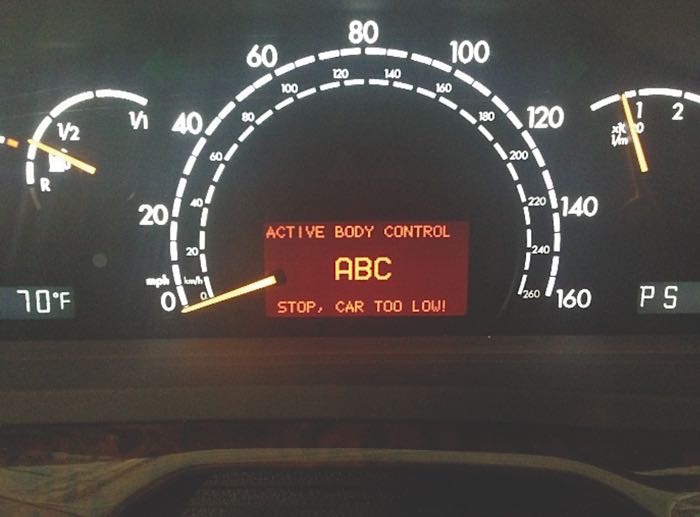It doesn’t seem that long ago when the closest we came to any kind of active suspension on a Mercedes-Benz was the self-leveling rear suspension systems on the station wagons and 560 models (SEL sedan and the SEC coupe). Of course, there were some exceptions — European models and the 450SEL 6.9 starting in the late ‘70s were available with hydraulic suspension at all four corners.
The majority of active suspension vehicles anyone would see had only the self-leveling feature. It was basic; there were no electronics. There was a small pump attached directly on the front of the engine and a mechanical connection to the rear sway bar. As the vehicle was loaded, the valve connected to the sway bar would increase fluid to the rear shocks, and the car would maintain normal ride height.
Some of the common failures were leaking shocks or bad accumulators. The accumulators would provide the soft ride, as the rear shocks were basically a hydraulic ram. These early systems needed little attention.
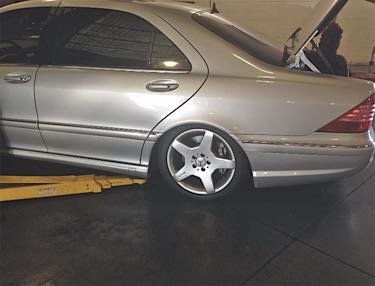
Mercedes then introduced the ABC (Active Body Control) suspension in Germany in 1999, and in the U.S. in 2000 on the S class coupes and sedans, and later on the SL. This system has a maintenance protocol that is not in the owner’s manual as required maintenance, as is brake fluid service every two years for example.
Work instructions are in the Mercedes WIS (work instruction system), document #AR32.50-P-0026A, “Flushing active body control (ABC) system.” There is a replaceable filter in the fluid reservoir. Follow the flushing instructions carefully. The instructions are also available on your service information system.
You will need a scanner that is capable of activating all of the suspension struts through a process called “rodeo.” It looks like the car is a bucking bronco, only slower. This allows the fluid to pass through the entire system so it can be completely flushed out.
Note: You must maintain the cleanest work area imaginable when working on an ABC system, as the smallest amount of dirt will ruin the car’s system and your day. If an ABC system drops slowly after being parked, there could be a small piece of dirt in one of the control valves. A fluid flush may help dislodge it.
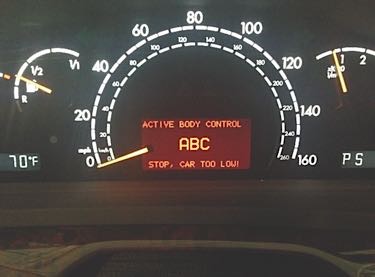
Any warning light complaint starts with checking codes and all TSBs. The warning lights in this system will be white or red — with red usually indicating to avoid driving the vehicle.
There is no shortage of sensors on this system:
- 3 – body acceleration sensors
- 2 – front-axle level sensors
- 2 – rear-axle level sensors
- 4 – strut motion sensors
- 1 – pressure sensor
- 1 – longitudinal acceleration sensor
- 1 – lateral acceleration sensor
- 1 – oil temperature sensor
Service Scenario
This 2004 S600 V12 Mercedes (see Photo 1) recently came into the shop with the rear suspension all the way down and the red warning on the dash. The pressure line to the rear had failed and the system lost all fluid and pressure. Rest assured, the pump was damaged as well.
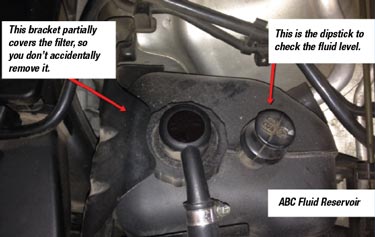
The ABC-equipped cars have a unique reservoir. If you don’t see this notation on the dash (see Photo 2), you may not have an ABC suspension, but rather an Airmatic suspension (air vs. hydraulic control). The mounting bracket (see arrow in Photo 3) is designed to prevent the removal of the system filter during routine fluid checks.
Service Precautions
The ABC system uses very high pressure, provided by a tandem power steering pump. And I do mean high pressure! Caution: System pressures run between 2,600 and 3,000 psi, so extreme care needs to be taken when working on it. Always follow the work instructions when depressurizing an ABC system before any repairs are performed. There are bleed screws to allow you to slowly release the system pressure (see Photo 4, #57, rear; image courtesy of Mercedes WIS).
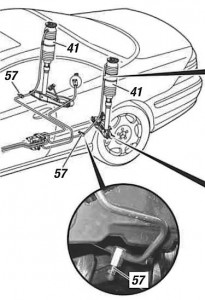
When you refill the system after a repair, Mercedes recommends using a separate special funnel with a filter that is stored in a locked or secure cabinet to prevent any contaminants from entering the system. Never let the tandem pump run with insufficient suspension fluid, as you will ruin a brand new pump that way. Have a second tech nearby to be sure the fluid reservoir never gets below the minimum level mark. As soon as the pump draws air in, it’s lights out.
System leaks should be repaired right away. If fluid can get out of the system, dirt can also get in. And as I indicated before, the smallest amount of dirt can lead to expensive repairs.
There are also several accumulators on an ABC system that can cause strange noises, warning lights to come on and poor ride quality. While I covered the fluid side of the ABC system in this article, you may also see failures on the electric and sensor side of the system on occasion. Be sure to follow the required testing and the job will go smoothly.
As you become more familiar with the system, its operation, safety precautions and proper repair procedures, you will be able to work on these systems with confidence.

